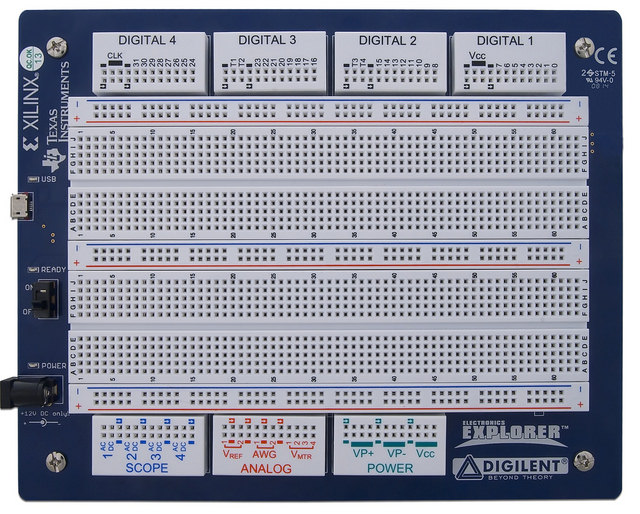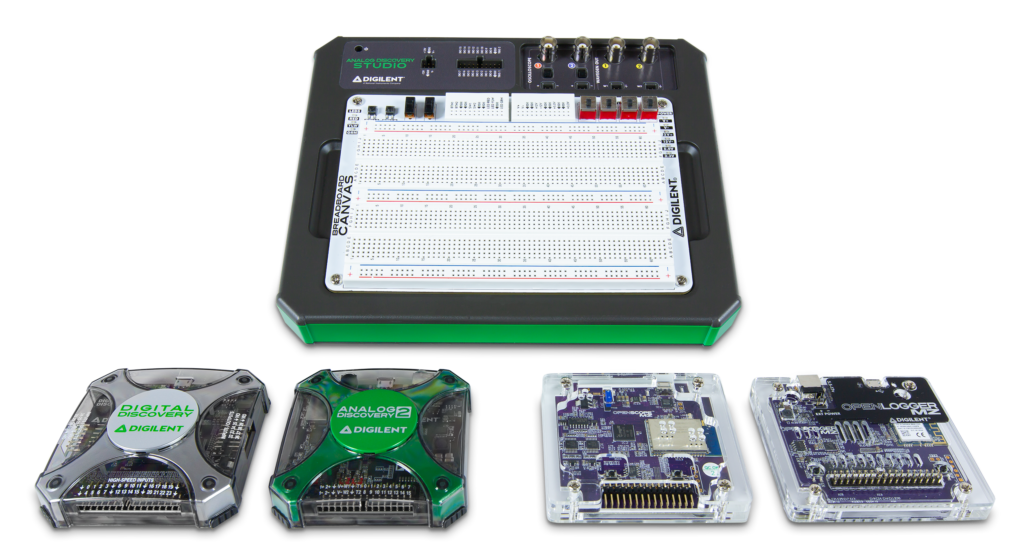First of all, we want to say thank you to all who visited our booth and chatted with us at ECEDHA 2019! We had an amazing time and saw some awesome stuff.
For those that weren’t here during the conference or the Digilent spotlight session, our president Steve Johnson gave a presentation on the state of the company and made an important announcement!
Even if you could not make it to the presentation, we have some exciting news. We are launching our latest product in the Test and Measurement line, the Analog Discovery Studio!

“The Analog Discovery Studio is a fully functional, portable test and measurement device that can turn any cross-functional space into a pop-up electronics laboratory. With lab spaces decreasing and student enrollment increasing, many institutions are choosing studio learning as a supplement to traditional laboratories.
With an Analog Discovery Studio, students can have a lab experience in the library, a classroom, or in a coffee shop.”
This new product release takes us back to our roots. Digilent was founded with a mission in education by professors in the WSU Electrical Engineering department. We are headquartered in Seattle, WA and have locations around the world including in Cluj, Romania and Shanghai, China. We have over 300 active products used by thousands of institutions world-wide.

In addition to our Test and Measurement devices, Digilent offers FPGA trainers and development boards, Pmod expansion modules. Our Test and Measurement solutions are flexible, accessible, and portable. They combine professional lab bench quality instruments with flexible software based tools, in a portable form factor.

The Analog Discovery Studio launch comes in the wake of the retirement of the Electronics Explorer Board. This board was our first student-owned test and measurement multi-tool and the physical inspiration for this new generation of tools.

Over the last 14 years, we’ve received a lot of valuable feedback from academic Analog Discovery 2 and Electronics Explorer Boards, and determined the need for an all-in-one device suitable for “pop-up labs” or check-out systems. Our goal is to support studio learning with some of the best parts of the Analog Discovery 2 and Electronics Explorer Board.

Introducing Analog Discovery Studio!

Analog Discovery Studio is a Test and Measurement device featuring the same 12 instruments available on the Analog Discovery 2, in a breadboardable form factor with BNC probe access.

Student enrollment in academic institutions around the world is increasing faster than lab spaces can support, which is leading many institutions to choose studio learning as a supplement to the traditional laboratory. The Analog Discovery Studio will enable students to continue laboratory hands on learning in the library, pop-up labs, tutoring centers, a classroom, coffee shop, or anywhere engineering happens.



I see it lacking 2 vital things, that I love the Electronics Explorer for:
1. Truly flexible power supplies/1-quadrant SMUs (effectively)
2. 4-channel scope
Lose half the digital channels for all I care. This is Analog Discovery, the digital capabilities aren’t all that anyway…
Over the few years, the programmable CV/CC supplies with 0…(+-)9V, up-to-1.5A output have been the most useful instrument on the board, one that I sorely missed when using my Analog Discovery 2 at home. Being able to select the maximum current you want to use, and to simulate higher voltage inputs to test your DC/DC regulation etc… gold. The one thing I was hoping, if ever an EE2 appeared, it would have programmable loads as well (though I wasn’t hoping very hard: the power dissipation requirements don’t really mesh with the format).
Another thing I was missing on the AD2, was the four-channel scope:
* Want to evaluate voltage and current going into and out of your power supply?
-Need either four channel scope, or a power supply with precise readouts. EE has both, ADS has neither.
* Need to see your RS232 data and RTS/CTS flow control, to see why you’re receiveing broken URCs from uBlox?
– Need the four-channel scope. No, the logic analyzer is not enough, as you can’t set the thresholds. RS232 is not 3.3V logic.
* Need to actually verify your CAN-over-CAT5 is in-spec?
– Can be done with two channels and the logic analyzer (for input and output digital signals into the transceiver), but it would be so much easier with 4 channel scope.
* Need to quickly evaluate a bunch of different LEDs for brightness and Vf over If?
– Need a programmable-current-limit supply.
This “successor” makes everything harder and none of it easier (except BNC ports. Those are good. But not worth the lost features). It looks like just an AD2 with some extra connectors. It’s a minimal step up from AD2, and a huge step down from EE, that it’s supposed to replace.